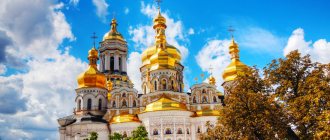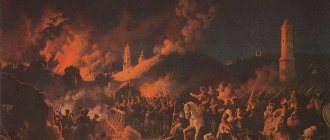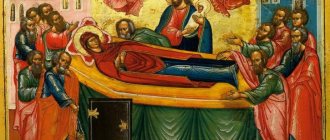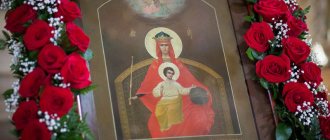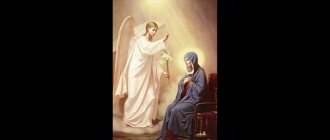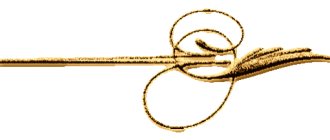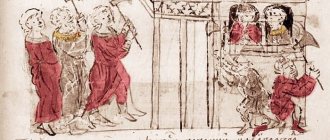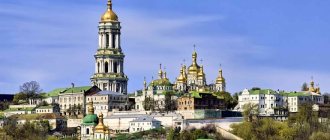| Kiev-Pechersk Icon of the Dormition of the Mother of God |
Kiev-Pechersk Icon of the Dormition of the Mother of God
Celebration May 3, August 15
The main shrine of the Great Church and the entire Lavra. It was located above the royal doors of the main throne.
This icon has a miraculous origin associated with the construction of the Assumption Cathedral of the Kiev Pechersk Lavra. This icon was brought to Kyiv in 1073 by Greek craftsmen, to whom it was presented by the Most Holy Theotokos Herself in the Blachernae Church and who built the Great Lavra Church. The relics of four architects and eight icon painters who arrived ten years later rest in the Near Caves.
| Kiev-Pechersk icon “Assumption of the Blessed Virgin Mary” (with the upcoming Venerables Anthony and Theodosius of Kiev-Pechersk). 1st half XIX century List from the miraculous icon. Church of the Exaltation of the Cross of the Kiev Pechersk Lavra |
The icon was written in ancient Greek script on a cypress board 9 inches wide and 6 inches high.
The Mother of God is depicted on the icon resting on a bed, in front of which stands the Gospel. The Gospel covered a hole deep into the board, where there were particles of the relics of the seven holy martyrs, placed by the temple builders at the foundation of the church. At the head of the Mother of God there are six apostles, of which St. ap. Peter is depicted with a censer; at Her feet are five apostles, and St. ap. Paul is depicted falling on the left side at the feet of the Mother of God. In the middle, on the left side, the Savior is depicted holding the soul of the Virgin Mary in swaddling clothes, and at the top, near His head, two angels with white trims are depicted. Reverends Anthony and Theodosius of Pechersk placed the icon above the Royal Doors of the newly built temple in a golden round icon case, generously decorated with diamonds. This entire circle with the miraculous icon was lowered down daily, at the end of Matins and Liturgy, on strong silk cords for reverent attachment to the image of the pilgrims.
The trace of the Kiev-Pechersk Icon of the Assumption of the Mother of God is lost after the explosion of the Assumption Cathedral in 1941. One of the copies of the ancient icon is now in the Holy Cross Church of the Kiev Pechersk Lavra above the royal gates. It has the same round icon case and is decorated like the original icon. He descends after each liturgy for worship according to the previous custom of the monastery.
Prayers
Troparion, tone 4
Today the Pechersk monastery triumphs brightly, / and the immeasurable face of the Pechersk fathers rejoices at the appearance of the image of the Mother of God, / with them we unceasingly cry out: // Rejoice, O Blessed One, Pechersk praise.
Kontakion, tone 3
Today the Virgin stands invisibly in the church / and from the faces of the Pechersk fathers she prays for us, / reverently magnifying Her immeasurable mercy to our race, / appearing in Her wonderful image, // the monastery Decorating Pecherskaya.
Icon of the Mother of God “Kievo-Pechersk”
Celebration day May 3/16 according to the new style
The icon was donated to the temple in 2008, dates back to the 19th century, wood, oil.
Troparion
Today the Pechersk monastery brightly triumphs and the immeasurable face of the Pechersk fathers rejoices at the appearance of the image of the Mother of God, and with them we incessantly cry out: Rejoice, Blessed One, Pechersk praise.
Prayer
Oh, Most Holy and Immaculate Virgin Mary, our Pechersk praise and adornment, sovereign protection of this holy place, true Lady of Her chosen destiny. Receive us, Your unworthy servants, a wretched prayer, offering with faith and love before Your wonderful image, and mercifully visit our sinful life, enlightening it with the light of repentance, autumn us, burdened with many sorrows, Your Heavenly joy, grant us ever to glorify You in the world and piety in this holy place, yes, having passed the path of our life without blemish, with Your help we will achieve eternal joy in the lordship of our holy and God-bearing fathers Anthony and Theodosius and all the saints of Pechersk, and with one mouth and heart we will praise You with Your Eternal Son and His Beginning Father and His Most Holy, Life-Giving, All-Good and Consubstantial Spirit forever and ever. Amen.
According to legend,
The Kiev-Pechersk Icon of the Mother of God was painted by the first Russian icon painter, Venerable Alipius[1] († 1114), hieromonk of the Pechersk monastery.
In the icon, the Mother of God solemnly sits on a high throne. The Infant Christ, sitting on the lap of His Most Pure Mother, blesses Theodosius and Anthony of Pechersk standing in front of the throne with the Divine right hand. These are the oldest images of Saints Anthony and Theodosius. Iconographically, the image of the Mother of God belongs to the Panahranta (All-Merciful) type. According to legend, the icon was painted in memory of the events in the Blachernae Church, when the Most Holy Theotokos called the architects and, handing them the icon of the Assumption, blessed them to go to Kyiv. The size of the icon is 42x67 cm. Until 1288, it was in the Kiev Pechersk Lavra, where it became famous for many miracles.
In 1288, Prince Roman Mikhailovich, while staying in Bryansk, became blind. Having heard about miracles and healings performed in Kyiv from the Pechersk Icon of the Mother of God, in the hope of healing, he sent a messenger to the Pechersk Monastery with a request to bring the miraculous image. After consulting with the brethren, the Pechersk archimandrite released the Lavra shrine to Bryansk on boats along the Desna. On the way, those accompanying the icon stopped for the night, and when they woke up in the morning, they discovered that the icon had disappeared. In search of her, the travelers went ashore and climbed the mountain opposite the Svenya River. Here they found a shrine standing on a large oak tree between the branches. When the news of the miracle reached Prince Roman, he, accompanied by the priesthood, went to where the Mother of God erected her icon. In fervent prayer, he turned to the Most Holy Theotokos with a request to grant him his lost sight and a promise: “Everything that I see from this place in all four directions, I will give to Your house. I will build a temple and a monastery in this place that You have loved.”
When the prince finished his prayer, his vision returned to him. In gratitude for the healing, a prayer service was served in front of the Pechersk Icon. Soon, at the site where the icon was found, the prince erected a temple in honor of the Dormition of the Blessed Virgin Mary, and then founded the Svensky Dormition Monastery here, in which he placed the miraculous icon, decorating it with a golden robe.
Currently, the miraculous image of the Kiev-Pechersk (or Svensk) Mother of God is kept in Moscow in the Tretyakov Gallery.
The veneration of the Pechersk Icon of the Mother of God is evidenced by its numerous lists.
One of the copies of the miraculous icon, written around the 19th century, by the grace of God, is in our church.
In 2007, the Pechersk Icon of the Mother of God with the upcoming Anthony and Theodosius was donated to our church by one believing family. According to their stories, the icon was in a village church in central Russia. During Soviet times, the temple was closed. All church relics and utensils were looted. The icon of the Pechersk Mother of God was saved. For many years it was kept in this family. But the family felt it needed to be given to the temple. Having settled in a new apartment, all family members became parishioners of our temple. After some time, they decided to transfer the family treasure to their favorite temple.
The icon needed restoration. Unfortunately, the restoration process did not progress as quickly as we would have liked. The icon was painted without gravy preparation, using tempera paints on wood, which complicated the restoration process. Therefore, it was decided not to undertake serious restoration work. We fixed the layer that is there. In general, the icon has the proper appearance, as they say, the icon is readable. Although it has not reached us in its original form. The side elements on which the archangels were depicted have been lost.
At the expense of the parishioners, the salary and decorations were ordered. Rostov jeweler Oleg Dmitrievich Abaidulin made applied elements using silver and gold, and gilded halos. He made the crown of the Blessed Virgin Mary from silver and decorated it with many semi-precious zircon stones.
On August 12, 2008, on the day of the joyful event of the parish - the patronal feast day, the renewed shrine took its place in the church. This was another joyful event of the holiday! Another gift to believers. According to parishioners, they fell in love with her from the very first days.
The ancient icon was a real decoration of the temple. And in its form it fits well into the icon series. Many icons in our church are new painted. She is one of the ancients.
Nowadays a special tradition has developed in Russia. Many priests specifically look for ancient icons in antique stores. They collect money, redeem the shrines and return them to the temples.
Thus, with the participation of parishioners, shrines that have their own history, in which there is a special tradition and a certain antiquity - a certain special grace, are returned to churches for general worship.
Natalya Avrutskaya, parishioner of the Church of the Holy Martyr John the Warrior
Used Books:
- Venerable Alypius of Pechersk, icon painter. Orthodox calendar https://days.pravoslavie.ru/Life/life6400.htm
- “Shrines of the Kiev-Pechersk Lavra”, Kyiv. Printing house of the Kiev-Pechersk Lavra 2007.
[1]Reverend Alypius is the founder of the Russian school of icon painting. “The Tale of the First Russian Icon Painter Alipiya” (Slovo 34 “Kievo-Pechersk Patericon”) consists mainly of stories about the miracles he performed or happened to his icons. Nowadays the holy relics of the Monk Alypius, like the relics of his teachers - Byzantine masters, rest incorruptibly in the Near Caves of the Kiev-Pechersk Lavra
History of the Dormition of the Virgin Mary
Tradition says that from the moment of the crucifixion of Her Son, Mary often came to Calvary and offered prayers to Heaven at the tomb of Jesus.
It happened that one day, while praying to the Mother of God, the Archangel Gabriel appeared and informed Her of his imminent death. The news for the grieving Mother was joyful and meant a quick meeting with her beloved Son. Therefore, the Blessed Virgin lived the last days of her earthly life in incessant prayer to the Lord, calling on all Orthodox Christians to follow her example.
Important. At the moment of the departure of the soul of the Most Pure Virgin, Jesus Christ Himself appeared at the Mother’s deathbed. He was surrounded by a host of heavenly angels and archangels.
The body of the Blessed Virgin was buried in the family tomb, next to her parents and husband. The burial ceremony itself was very solemn and was fenced off from the outside world by an invisible wall. And infidels who tried to prevent the burial of the body were severely punished.
Mary's tomb was tightly closed with a huge stone. Three days after the funeral, the Apostle Thomas visited Jerusalem. He was eager to say goodbye to the Mother of God and attend Her burial, but he was late. In tears, he begged Christians to open the grave in order to contemplate the Most Pure One for the last time.
But when people moved the stone away and entered inside the tomb, a miracle was revealed to them - there was no body in it, and in its place lay only Mary’s funeral robe. After all, the Lord Himself took the mother’s soul in his hands and together they ascended to Heaven.
On the same day, the apostles gathered at a common table to celebrate the resurrection and ascension of the Blessed Virgin. And then the Most Pure One Herself appeared to them and proclaimed: “I am with you!” To this day, the Mother of God is invisibly next to every believer, protecting him and fulfilling heartfelt requests.
On this day, festive services are held in churches, the clergy puts on blue vestments. The Feast of the Assumption is celebrated with special solemnity in Gethsemane, at the burial site of the Most Pure Virgin.
About other Mother of God holidays:
- Introduction to the Temple of the Blessed Virgin Mary
- Protection of the Blessed Virgin Mary
- Nativity of the Blessed Virgin Mary
The sacred shroud of the Mother of God, surrounded by lighted candles, is kept in the monastery courtyard. Before it, from the beginning of the Feast of the Transfiguration of Christ, the service of prayers, akathists, liturgies and evening services begins.
At 2 o'clock in the morning before the day of the Assumption, the rector of the Gethsemane metochion celebrates the Divine Liturgy, and at its end a prayer service is read before the shroud. After this, she is solemnly transferred in a procession to Gethsemane.
This event is annually attended by members of the Russian clergy in Jerusalem. The procession is always accompanied by a huge number of pilgrims from all over the world. The procession of the cross arrives in Gethsemane at sunrise, and the shroud is laid in the stone cave where the Most Pure Body of the Mother of God previously lay.
On the morning of the day of the Assumption, the rite of burial of the Mother of God is performed. Bishops, monks, clergy and many Orthodox people travel through the narrow streets of the holy city to Gethsemane.
The funeral procession sings a prayer canon to the Mother of God. At the celebration of the holiday, the shroud returns in the same religious procession back to Jerusalem to its Gethsemane courtyard.
Meaning of the icon
The amazingly beautiful Svensky image measures 67x42 cm.
Despite its small size, it contains:
- the seated Holy Virgin Mary;
- Child Christ;
- Theodosius of Pechersk;
- Anthony of Pechersk.
Due to its age, the painting is quite worn and there are many inscriptions of later dates on it, however, despite this, the characters depicted can still be clearly seen. The Most Pure Virgin sits on the throne so that her right leg rests on a small stone, and her left leg rests on the pulpit. The throne itself is golden, and its base is made in the form of arches. The Child Christ is on the left hand of the Mother of God and blesses people with his fingers.
The founders of Russian monasticism, Theodosius and Anthony, stand on the right and left hands of the Mother of God, respectively, and hold scrolls. Theodosius is depicted with his head uncovered and in a robe, but Anthony is dressed in schematic vestments.
Theodosius and Anthony are the founders of monasticism in Rus', who created the eastern branch of Christian monasticism. Theodosius was canonized third in Rus', immediately after the innocently murdered princes Boris and Gleb. They hold scrolls, on each of which is written a prayer to the Holy Virgin and a petition for pardon for Rus'.
Read about other Orthodox saints:
- Saint Mitrophan of Voronezh
- Venerable Paisiy Svyatogorets
- Holy Great Martyr John the New, Sochaevsky
The Virgin Mary depicted on the throne symbolizes her power as the Queen of Heaven. This is how the Virgin Mary was often depicted, trying to show her strength and power on earth. This image is repeated in almost every icon painted in Byzantium.
